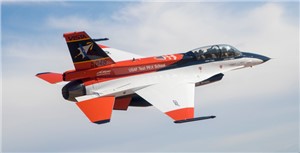ACE Program's AI Agents Transition from Simulation to Live Flight
February 14, 2023
-In less than three years, artificial intelligence (AI) algorithms developed under DARPA’s Air Combat Evolution (ACE) program have progressed from controlling simulated F-16s flying aerial dogfights on computer screens to controlling an actual F-16 in flight.
In early December 2022, ACE algorithm developers uploaded their AI software into a specially modified F-16 test aircraft known as the X-62A or VISTA (Variable In-flight Simulator Test Aircraft), at the Air Force Test Pilot School (TPS) at Edwards Air Force Base, California, and flew multiple flights over several days. The flights demonstrated that AI agents can control a full-scale fighter jet and provided invaluable live-flight data.
The ACE AI flights were a part of a successful broader test event including DARPA, TPS, and the Air Force Research Laboratory, enabling multiple Defense Department organizations to work closely together with AI-development contractors toward shared objectives.
“Thanks to the outstanding teamwork and coordination between DARPA, the Air Force Test Pilot School, the Air Force Research Laboratory, and our performer teams, we’ve made rapid progress in Phase 2 across all areas of the ACE program,” said Air Force Lt. Col. Ryan “Hal” Hefron, the DARPA program manager for ACE. “VISTA allowed us to streamline the program by skipping the planned subscale phase and proceeding directly to a full-scale implementation, saving a year or more and providing performance feedback under real flight conditions.”
DARPA performers EpiSci, PhysicsAI, Shield AI, and the Johns Hopkins Applied Physics Laboratory flew different F-16 AI algorithms on the X-62A. The aircraft, a highly modified two-seat F-16, can be programmed to demonstrate the flight-handling characteristics of a variety of different aircraft types. VISTA was upgraded recently with the System for Autonomous Control of Simulation (SACS), making the aircraft a perfect platform to test ACE’s autonomous F-16 AI agents. A safety pilot was on board the VISTA aircraft to take control if anything went awry.
“We conducted multiple sorties [takeoffs and landings] with numerous test points performed on each sortie to test the algorithms under varying starting conditions, against various simulated adversaries, and with simulated weapons capabilities,” Hefron said. “We didn’t run into any major issues but did encounter some differences compared to simulation-based results, which is to be expected when transitioning from virtual to live. This highlights the importance of not only flight testing advanced autonomous capabilities but doing so on testbeds like VISTA, which allowed us to rapidly learn lessons and iterate at a much faster rate than with other air vehicles.”
The Test Pilot School is also supporting the ACE program in measuring how well pilots trust the AI agent to conduct within-visual-range air combat (called a dogfight) while the human pilot focuses on larger battle management tasks in the cockpit. Air Force test pilots have flown numerous live flights in L-29 jet trainers at the University of Iowa Technology Institute’s Operator Performance Laboratory (OPL), an ACE performer. The two-seat L-29 jets at OPL are outfitted with sensors in the cockpit to measure pilot physiological responses, giving researchers clues as to whether the pilot is trusting the AI or not. The TPS recently hosted an ACE Trust Capstone event in late January 2023 using simulators to gauge pilot-agent alignment with follow-on trust-calibration flights in the X-62A planned for later this year.
Begun in 2019, ACE aims to develop trusted, scalable, human-level, AI-driven autonomy for air combat by using human-machine collaborative dogfighting as its challenge problem. In August 2020, the ACE program’s AlphaDogfight Trials pitted AI agents against each other flying simulated F-16s in a virtual dogfighting competition that culminated with the winning AI defeating an experienced F-16 fighter pilot flying in a simulator.
Source : DARPA

Related Studies


